NTUC Fairprice Hybrid System: Operation Management & Evaluation
VerifiedAdded on 2023/06/12
|30
|5786
|211
Report
AI Summary
This report evaluates NTUC Fairprice's potential implementation of a hybrid system, allowing customers to order goods online and have them delivered. It uses soft systems methodology to identify potential issues like high delivery costs, reduced profit margins, and delivery inefficiencies. The report compares different business models, such as Business to Business, Business to Consumer, and Business to Government, recommending strategies for maintaining competitiveness. It also addresses the parcel conundrum, emphasizing the importance of customer location and communication to minimize missed deliveries and environmental impact. Furthermore, the report discusses how managers can turn performance objectives into operational priorities and the resources needed for effective implementation. Finally, it uses a balanced scorecard to measure business performance post-implementation, considering customer, financial, internal process, and innovation and learning perspectives.
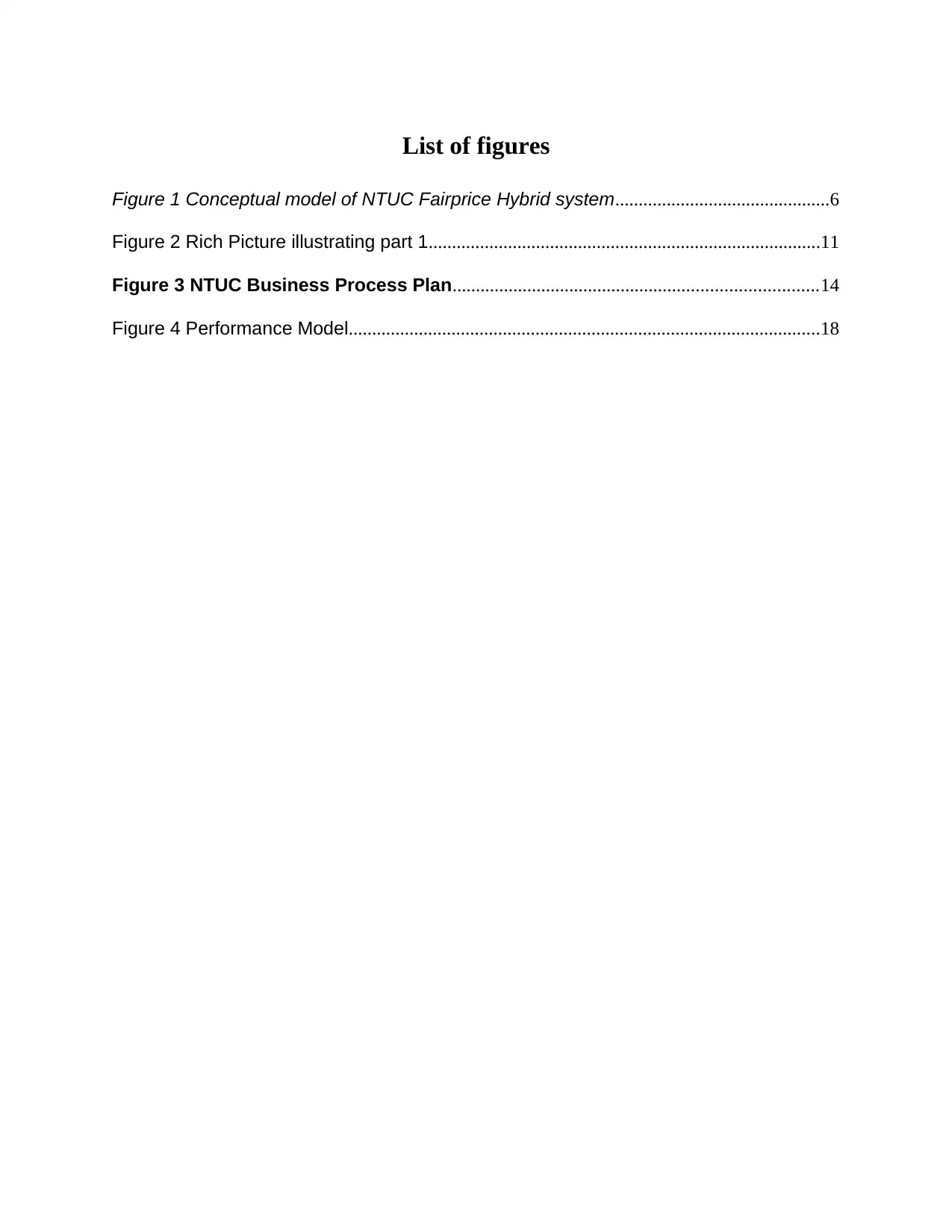
List of figures
Figure 1 Conceptual model of NTUC Fairprice Hybrid system..............................................6
Figure 2 Rich Picture illustrating part 1....................................................................................11
Figure 3 NTUC Business Process Plan..............................................................................14
Figure 4 Performance Model.....................................................................................................18
Figure 1 Conceptual model of NTUC Fairprice Hybrid system..............................................6
Figure 2 Rich Picture illustrating part 1....................................................................................11
Figure 3 NTUC Business Process Plan..............................................................................14
Figure 4 Performance Model.....................................................................................................18
Paraphrase This Document
Need a fresh take? Get an instant paraphrase of this document with our AI Paraphraser
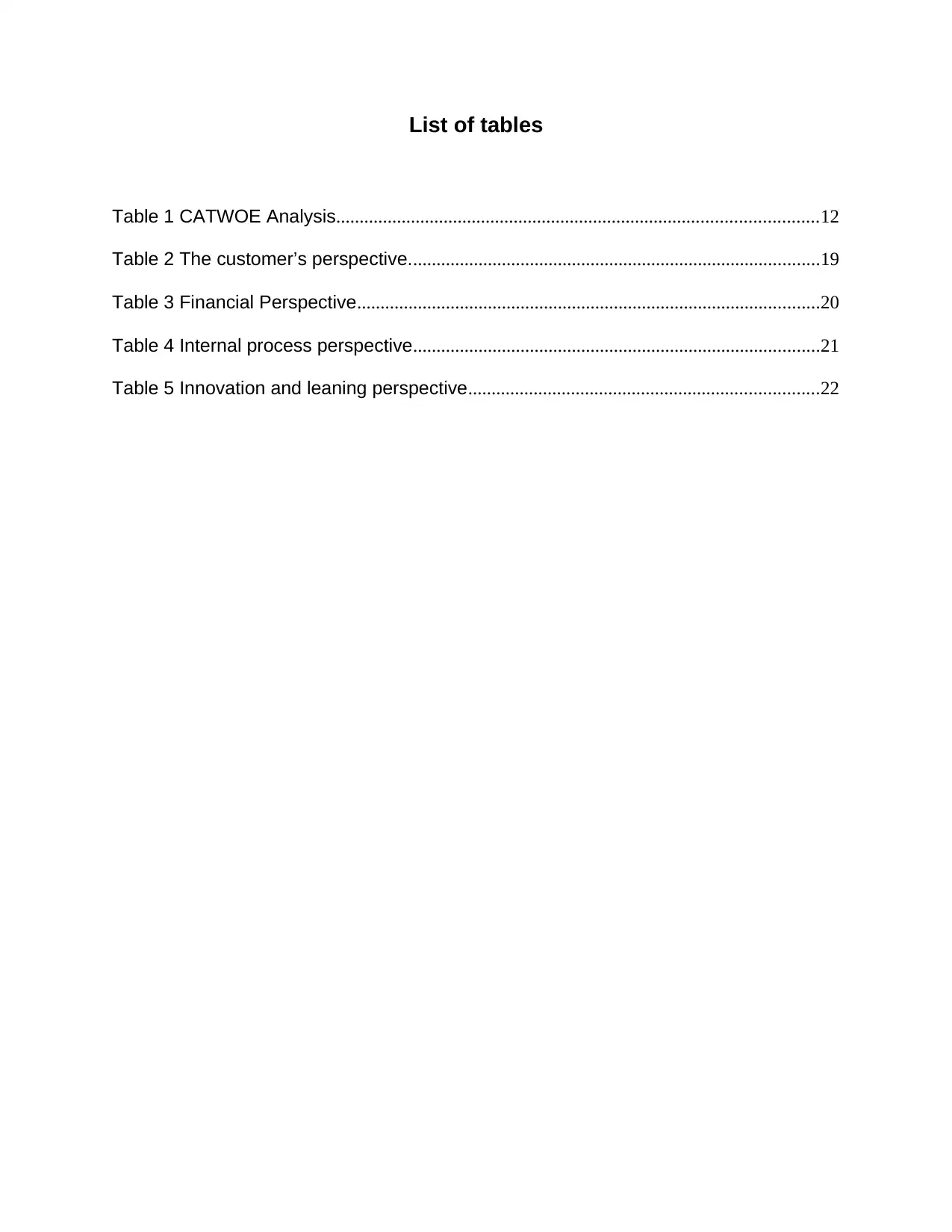
List of tables
Table 1 CATWOE Analysis.......................................................................................................12
Table 2 The customer’s perspective........................................................................................19
Table 3 Financial Perspective...................................................................................................20
Table 4 Internal process perspective.......................................................................................21
Table 5 Innovation and leaning perspective...........................................................................22
Table 1 CATWOE Analysis.......................................................................................................12
Table 2 The customer’s perspective........................................................................................19
Table 3 Financial Perspective...................................................................................................20
Table 4 Internal process perspective.......................................................................................21
Table 5 Innovation and leaning perspective...........................................................................22
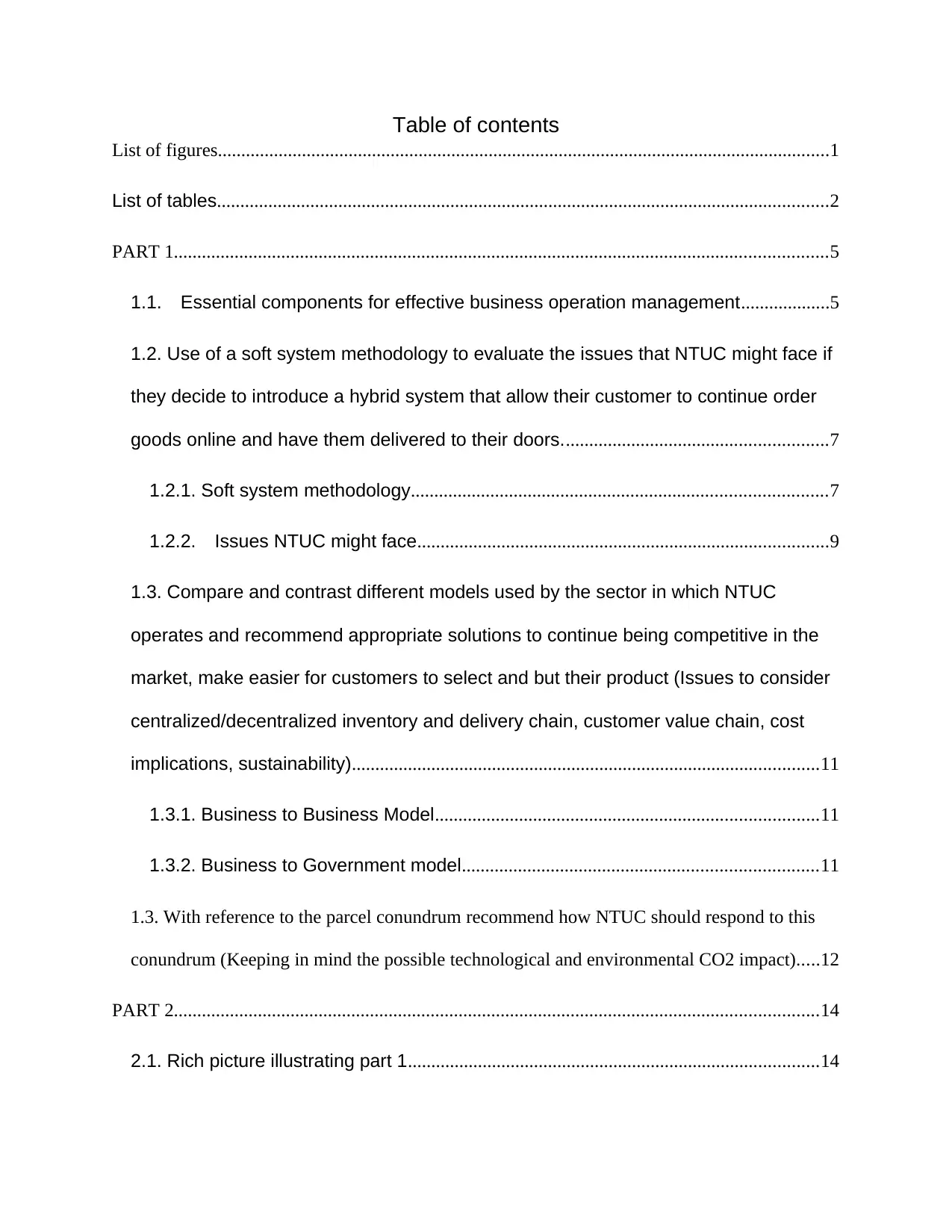
Table of contents
List of figures...................................................................................................................................1
List of tables...................................................................................................................................2
PART 1............................................................................................................................................5
1.1. Essential components for effective business operation management...................5
1.2. Use of a soft system methodology to evaluate the issues that NTUC might face if
they decide to introduce a hybrid system that allow their customer to continue order
goods online and have them delivered to their doors.........................................................7
1.2.1. Soft system methodology.........................................................................................7
1.2.2. Issues NTUC might face........................................................................................9
1.3. Compare and contrast different models used by the sector in which NTUC
operates and recommend appropriate solutions to continue being competitive in the
market, make easier for customers to select and but their product (Issues to consider
centralized/decentralized inventory and delivery chain, customer value chain, cost
implications, sustainability)....................................................................................................11
1.3.1. Business to Business Model..................................................................................11
1.3.2. Business to Government model............................................................................11
1.3. With reference to the parcel conundrum recommend how NTUC should respond to this
conundrum (Keeping in mind the possible technological and environmental CO2 impact).....12
PART 2..........................................................................................................................................14
2.1. Rich picture illustrating part 1........................................................................................14
List of figures...................................................................................................................................1
List of tables...................................................................................................................................2
PART 1............................................................................................................................................5
1.1. Essential components for effective business operation management...................5
1.2. Use of a soft system methodology to evaluate the issues that NTUC might face if
they decide to introduce a hybrid system that allow their customer to continue order
goods online and have them delivered to their doors.........................................................7
1.2.1. Soft system methodology.........................................................................................7
1.2.2. Issues NTUC might face........................................................................................9
1.3. Compare and contrast different models used by the sector in which NTUC
operates and recommend appropriate solutions to continue being competitive in the
market, make easier for customers to select and but their product (Issues to consider
centralized/decentralized inventory and delivery chain, customer value chain, cost
implications, sustainability)....................................................................................................11
1.3.1. Business to Business Model..................................................................................11
1.3.2. Business to Government model............................................................................11
1.3. With reference to the parcel conundrum recommend how NTUC should respond to this
conundrum (Keeping in mind the possible technological and environmental CO2 impact).....12
PART 2..........................................................................................................................................14
2.1. Rich picture illustrating part 1........................................................................................14
⊘ This is a preview!⊘
Do you want full access?
Subscribe today to unlock all pages.

Trusted by 1+ million students worldwide
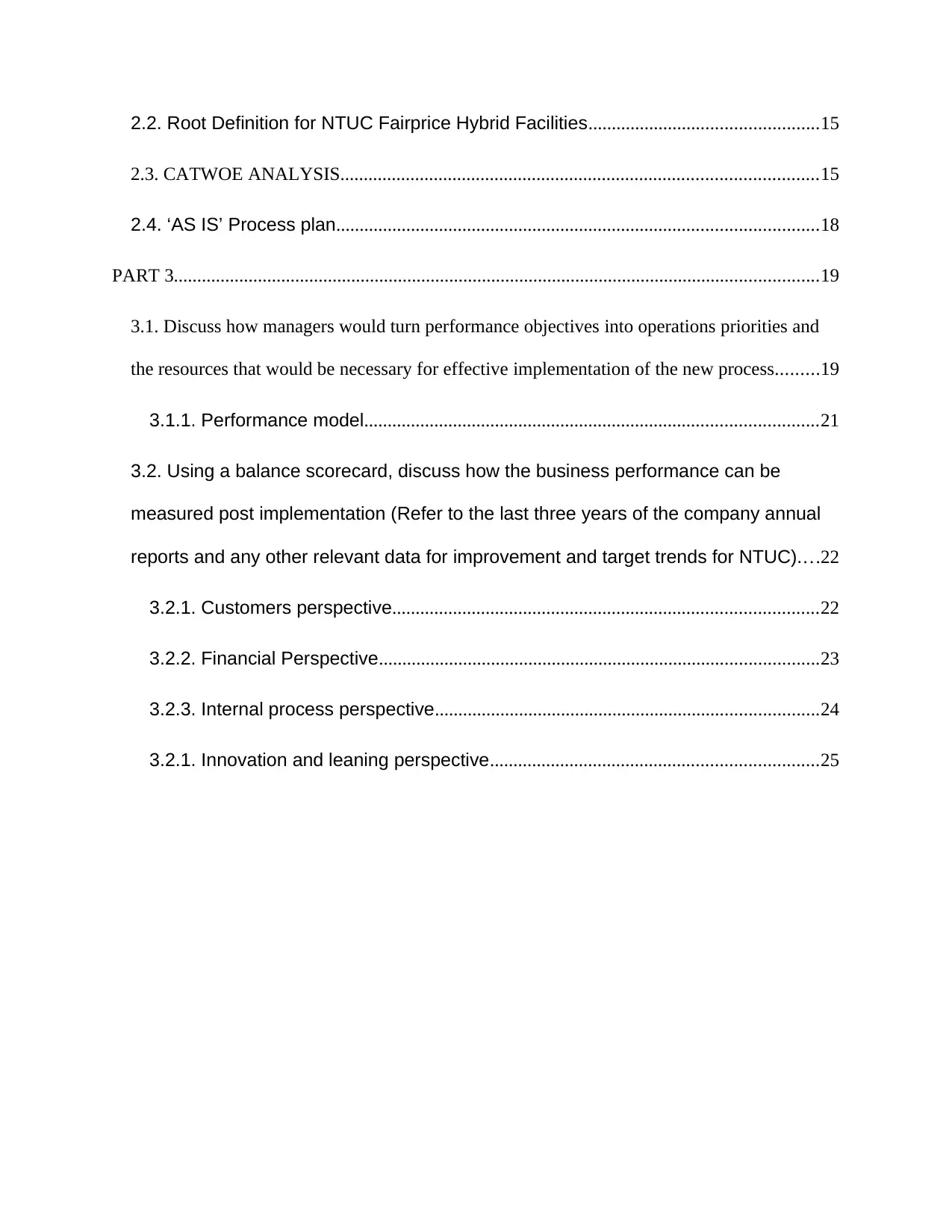
2.2. Root Definition for NTUC Fairprice Hybrid Facilities.................................................15
2.3. CATWOE ANALYSIS......................................................................................................15
2.4. ‘AS IS’ Process plan.......................................................................................................18
PART 3..........................................................................................................................................19
3.1. Discuss how managers would turn performance objectives into operations priorities and
the resources that would be necessary for effective implementation of the new process.........19
3.1.1. Performance model.................................................................................................21
3.2. Using a balance scorecard, discuss how the business performance can be
measured post implementation (Refer to the last three years of the company annual
reports and any other relevant data for improvement and target trends for NTUC)....22
3.2.1. Customers perspective...........................................................................................22
3.2.2. Financial Perspective..............................................................................................23
3.2.3. Internal process perspective..................................................................................24
3.2.1. Innovation and leaning perspective......................................................................25
2.3. CATWOE ANALYSIS......................................................................................................15
2.4. ‘AS IS’ Process plan.......................................................................................................18
PART 3..........................................................................................................................................19
3.1. Discuss how managers would turn performance objectives into operations priorities and
the resources that would be necessary for effective implementation of the new process.........19
3.1.1. Performance model.................................................................................................21
3.2. Using a balance scorecard, discuss how the business performance can be
measured post implementation (Refer to the last three years of the company annual
reports and any other relevant data for improvement and target trends for NTUC)....22
3.2.1. Customers perspective...........................................................................................22
3.2.2. Financial Perspective..............................................................................................23
3.2.3. Internal process perspective..................................................................................24
3.2.1. Innovation and leaning perspective......................................................................25
Paraphrase This Document
Need a fresh take? Get an instant paraphrase of this document with our AI Paraphraser
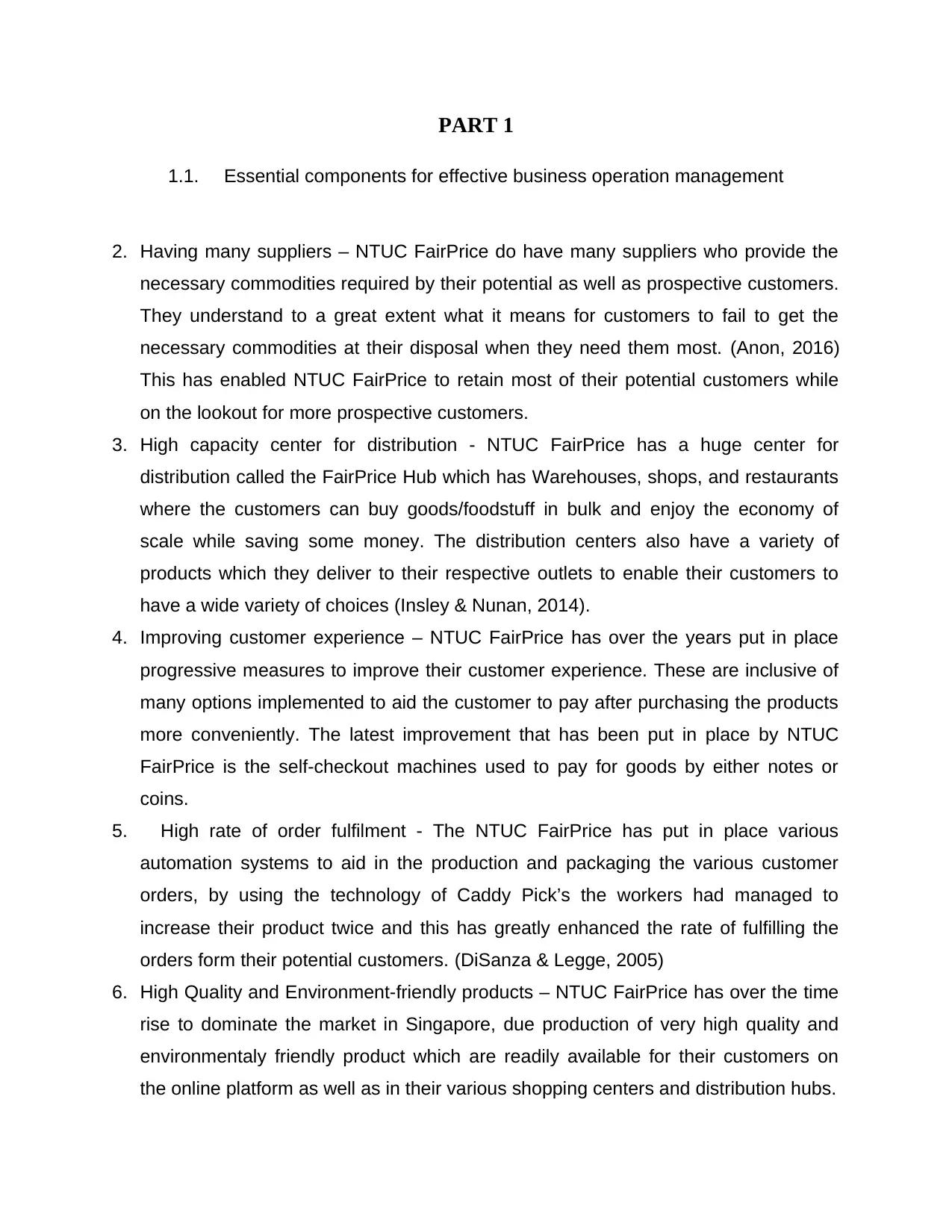
PART 1
1.1. Essential components for effective business operation management
2. Having many suppliers – NTUC FairPrice do have many suppliers who provide the
necessary commodities required by their potential as well as prospective customers.
They understand to a great extent what it means for customers to fail to get the
necessary commodities at their disposal when they need them most. (Anon, 2016)
This has enabled NTUC FairPrice to retain most of their potential customers while
on the lookout for more prospective customers.
3. High capacity center for distribution - NTUC FairPrice has a huge center for
distribution called the FairPrice Hub which has Warehouses, shops, and restaurants
where the customers can buy goods/foodstuff in bulk and enjoy the economy of
scale while saving some money. The distribution centers also have a variety of
products which they deliver to their respective outlets to enable their customers to
have a wide variety of choices (Insley & Nunan, 2014).
4. Improving customer experience – NTUC FairPrice has over the years put in place
progressive measures to improve their customer experience. These are inclusive of
many options implemented to aid the customer to pay after purchasing the products
more conveniently. The latest improvement that has been put in place by NTUC
FairPrice is the self-checkout machines used to pay for goods by either notes or
coins.
5. High rate of order fulfilment - The NTUC FairPrice has put in place various
automation systems to aid in the production and packaging the various customer
orders, by using the technology of Caddy Pick’s the workers had managed to
increase their product twice and this has greatly enhanced the rate of fulfilling the
orders form their potential customers. (DiSanza & Legge, 2005)
6. High Quality and Environment-friendly products – NTUC FairPrice has over the time
rise to dominate the market in Singapore, due production of very high quality and
environmentaly friendly product which are readily available for their customers on
the online platform as well as in their various shopping centers and distribution hubs.
1.1. Essential components for effective business operation management
2. Having many suppliers – NTUC FairPrice do have many suppliers who provide the
necessary commodities required by their potential as well as prospective customers.
They understand to a great extent what it means for customers to fail to get the
necessary commodities at their disposal when they need them most. (Anon, 2016)
This has enabled NTUC FairPrice to retain most of their potential customers while
on the lookout for more prospective customers.
3. High capacity center for distribution - NTUC FairPrice has a huge center for
distribution called the FairPrice Hub which has Warehouses, shops, and restaurants
where the customers can buy goods/foodstuff in bulk and enjoy the economy of
scale while saving some money. The distribution centers also have a variety of
products which they deliver to their respective outlets to enable their customers to
have a wide variety of choices (Insley & Nunan, 2014).
4. Improving customer experience – NTUC FairPrice has over the years put in place
progressive measures to improve their customer experience. These are inclusive of
many options implemented to aid the customer to pay after purchasing the products
more conveniently. The latest improvement that has been put in place by NTUC
FairPrice is the self-checkout machines used to pay for goods by either notes or
coins.
5. High rate of order fulfilment - The NTUC FairPrice has put in place various
automation systems to aid in the production and packaging the various customer
orders, by using the technology of Caddy Pick’s the workers had managed to
increase their product twice and this has greatly enhanced the rate of fulfilling the
orders form their potential customers. (DiSanza & Legge, 2005)
6. High Quality and Environment-friendly products – NTUC FairPrice has over the time
rise to dominate the market in Singapore, due production of very high quality and
environmentaly friendly product which are readily available for their customers on
the online platform as well as in their various shopping centers and distribution hubs.

7. Free delivery of goods purchased online – NTUC FairPrice offers special free
delivery for goods purchased online, as a result, the effectiveness and the efficiency
of the business in Singapore have doubled off the years. It has enabled NTUC
FairPrice to meet their customer demands and add more value to their already high-
quality products.
delivery for goods purchased online, as a result, the effectiveness and the efficiency
of the business in Singapore have doubled off the years. It has enabled NTUC
FairPrice to meet their customer demands and add more value to their already high-
quality products.
⊘ This is a preview!⊘
Do you want full access?
Subscribe today to unlock all pages.

Trusted by 1+ million students worldwide
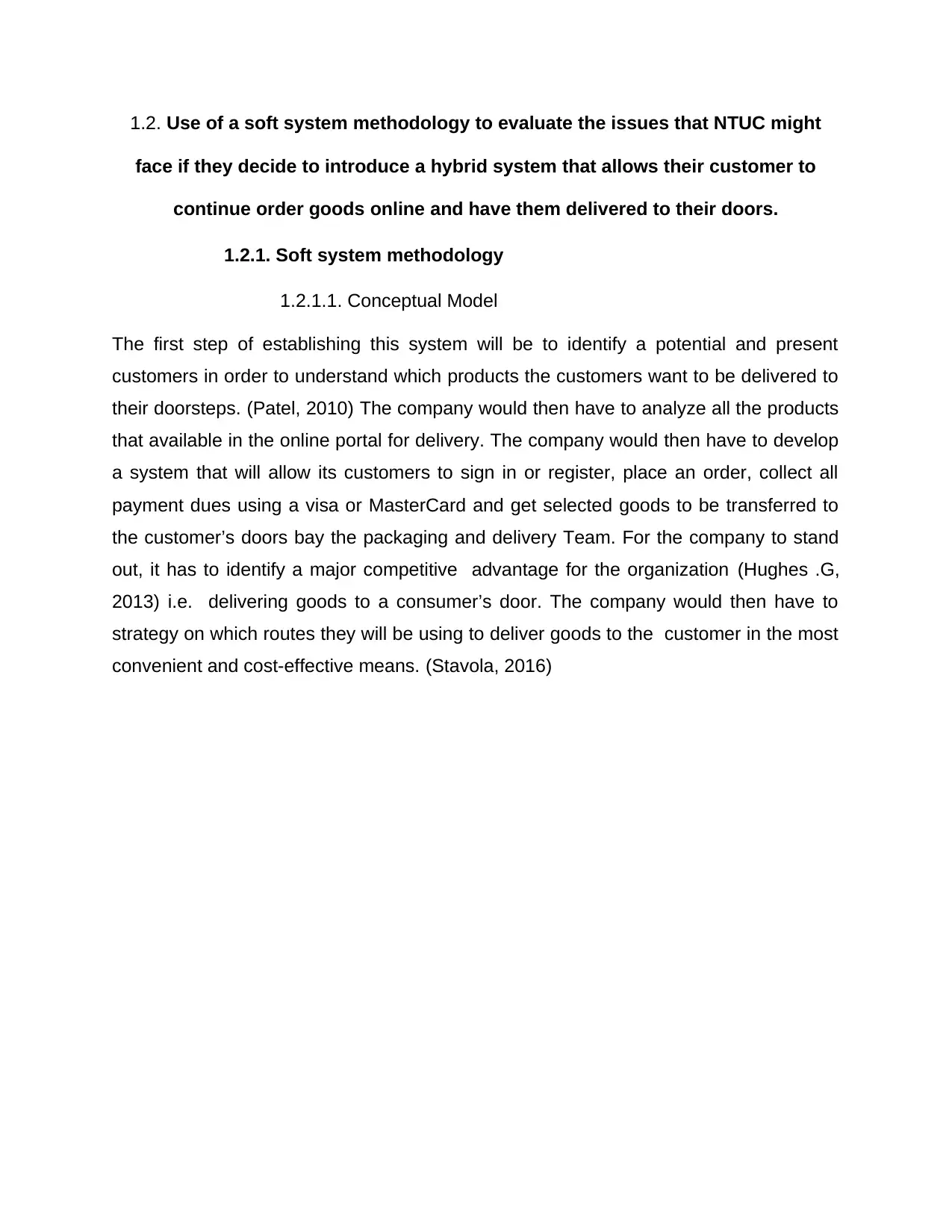
1.2. Use of a soft system methodology to evaluate the issues that NTUC might
face if they decide to introduce a hybrid system that allows their customer to
continue order goods online and have them delivered to their doors.
1.2.1. Soft system methodology
1.2.1.1. Conceptual Model
The first step of establishing this system will be to identify a potential and present
customers in order to understand which products the customers want to be delivered to
their doorsteps. (Patel, 2010) The company would then have to analyze all the products
that available in the online portal for delivery. The company would then have to develop
a system that will allow its customers to sign in or register, place an order, collect all
payment dues using a visa or MasterCard and get selected goods to be transferred to
the customer’s doors bay the packaging and delivery Team. For the company to stand
out, it has to identify a major competitive advantage for the organization (Hughes .G,
2013) i.e. delivering goods to a consumer’s door. The company would then have to
strategy on which routes they will be using to deliver goods to the customer in the most
convenient and cost-effective means. (Stavola, 2016)
face if they decide to introduce a hybrid system that allows their customer to
continue order goods online and have them delivered to their doors.
1.2.1. Soft system methodology
1.2.1.1. Conceptual Model
The first step of establishing this system will be to identify a potential and present
customers in order to understand which products the customers want to be delivered to
their doorsteps. (Patel, 2010) The company would then have to analyze all the products
that available in the online portal for delivery. The company would then have to develop
a system that will allow its customers to sign in or register, place an order, collect all
payment dues using a visa or MasterCard and get selected goods to be transferred to
the customer’s doors bay the packaging and delivery Team. For the company to stand
out, it has to identify a major competitive advantage for the organization (Hughes .G,
2013) i.e. delivering goods to a consumer’s door. The company would then have to
strategy on which routes they will be using to deliver goods to the customer in the most
convenient and cost-effective means. (Stavola, 2016)
Paraphrase This Document
Need a fresh take? Get an instant paraphrase of this document with our AI Paraphraser
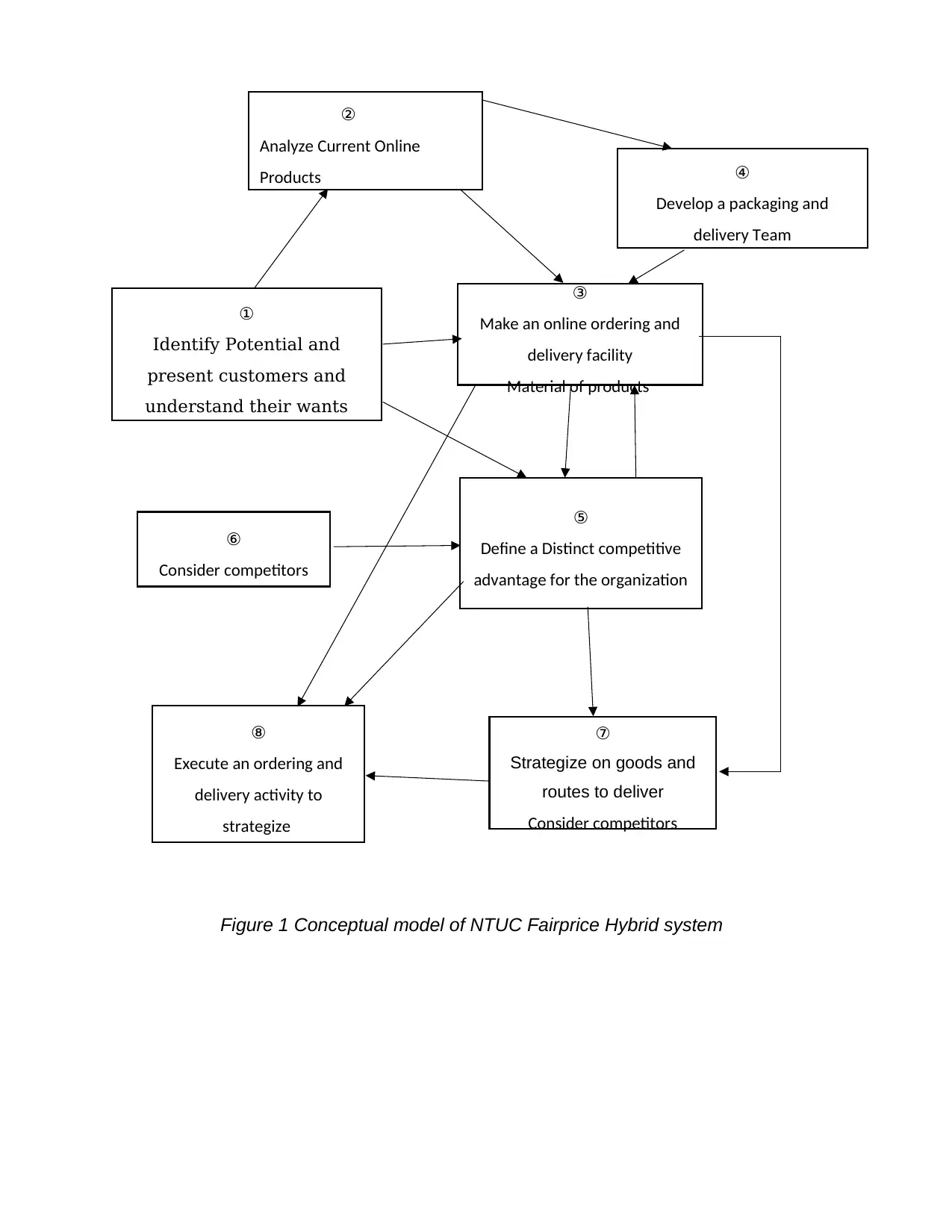
Figure 1 Conceptual model of NTUC Fairprice Hybrid system
⑥
Consider competitors
①
Identify Potential and
present customers and
understand their wants
⑤
Define a Distinct competitive
advantage for the organization
④
Develop a packaging and
delivery Team
③
Make an online ordering and
delivery facility
Material of products
②
Analyze Current Online
Products
⑧
Execute an ordering and
delivery activity to
strategize
⑦
Strategize on goods and
routes to deliver
Consider competitors
⑥
Consider competitors
①
Identify Potential and
present customers and
understand their wants
⑤
Define a Distinct competitive
advantage for the organization
④
Develop a packaging and
delivery Team
③
Make an online ordering and
delivery facility
Material of products
②
Analyze Current Online
Products
⑧
Execute an ordering and
delivery activity to
strategize
⑦
Strategize on goods and
routes to deliver
Consider competitors
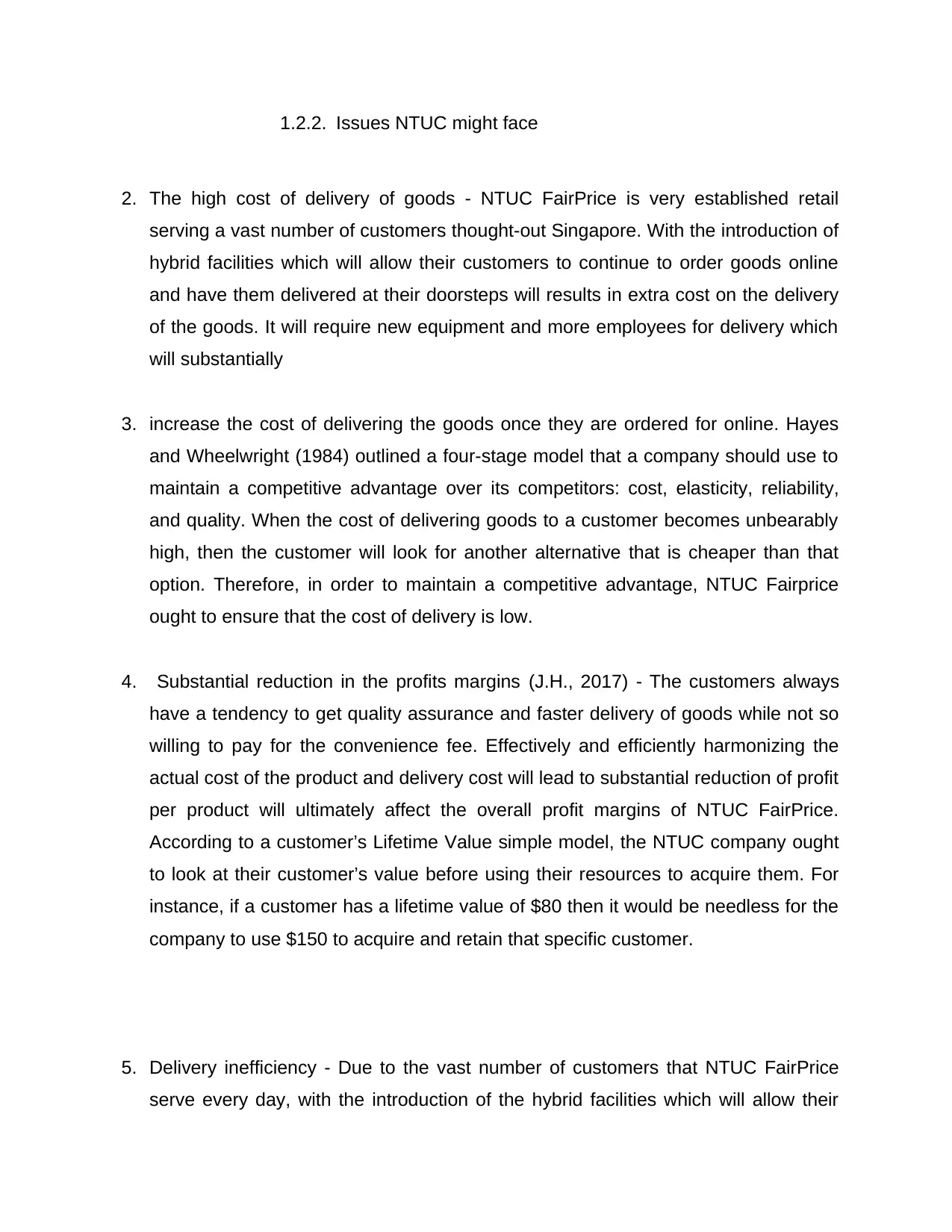
1.2.2. Issues NTUC might face
2. The high cost of delivery of goods - NTUC FairPrice is very established retail
serving a vast number of customers thought-out Singapore. With the introduction of
hybrid facilities which will allow their customers to continue to order goods online
and have them delivered at their doorsteps will results in extra cost on the delivery
of the goods. It will require new equipment and more employees for delivery which
will substantially
3. increase the cost of delivering the goods once they are ordered for online. Hayes
and Wheelwright (1984) outlined a four-stage model that a company should use to
maintain a competitive advantage over its competitors: cost, elasticity, reliability,
and quality. When the cost of delivering goods to a customer becomes unbearably
high, then the customer will look for another alternative that is cheaper than that
option. Therefore, in order to maintain a competitive advantage, NTUC Fairprice
ought to ensure that the cost of delivery is low.
4. Substantial reduction in the profits margins (J.H., 2017) - The customers always
have a tendency to get quality assurance and faster delivery of goods while not so
willing to pay for the convenience fee. Effectively and efficiently harmonizing the
actual cost of the product and delivery cost will lead to substantial reduction of profit
per product will ultimately affect the overall profit margins of NTUC FairPrice.
According to a customer’s Lifetime Value simple model, the NTUC company ought
to look at their customer’s value before using their resources to acquire them. For
instance, if a customer has a lifetime value of $80 then it would be needless for the
company to use $150 to acquire and retain that specific customer.
5. Delivery inefficiency - Due to the vast number of customers that NTUC FairPrice
serve every day, with the introduction of the hybrid facilities which will allow their
2. The high cost of delivery of goods - NTUC FairPrice is very established retail
serving a vast number of customers thought-out Singapore. With the introduction of
hybrid facilities which will allow their customers to continue to order goods online
and have them delivered at their doorsteps will results in extra cost on the delivery
of the goods. It will require new equipment and more employees for delivery which
will substantially
3. increase the cost of delivering the goods once they are ordered for online. Hayes
and Wheelwright (1984) outlined a four-stage model that a company should use to
maintain a competitive advantage over its competitors: cost, elasticity, reliability,
and quality. When the cost of delivering goods to a customer becomes unbearably
high, then the customer will look for another alternative that is cheaper than that
option. Therefore, in order to maintain a competitive advantage, NTUC Fairprice
ought to ensure that the cost of delivery is low.
4. Substantial reduction in the profits margins (J.H., 2017) - The customers always
have a tendency to get quality assurance and faster delivery of goods while not so
willing to pay for the convenience fee. Effectively and efficiently harmonizing the
actual cost of the product and delivery cost will lead to substantial reduction of profit
per product will ultimately affect the overall profit margins of NTUC FairPrice.
According to a customer’s Lifetime Value simple model, the NTUC company ought
to look at their customer’s value before using their resources to acquire them. For
instance, if a customer has a lifetime value of $80 then it would be needless for the
company to use $150 to acquire and retain that specific customer.
5. Delivery inefficiency - Due to the vast number of customers that NTUC FairPrice
serve every day, with the introduction of the hybrid facilities which will allow their
⊘ This is a preview!⊘
Do you want full access?
Subscribe today to unlock all pages.

Trusted by 1+ million students worldwide
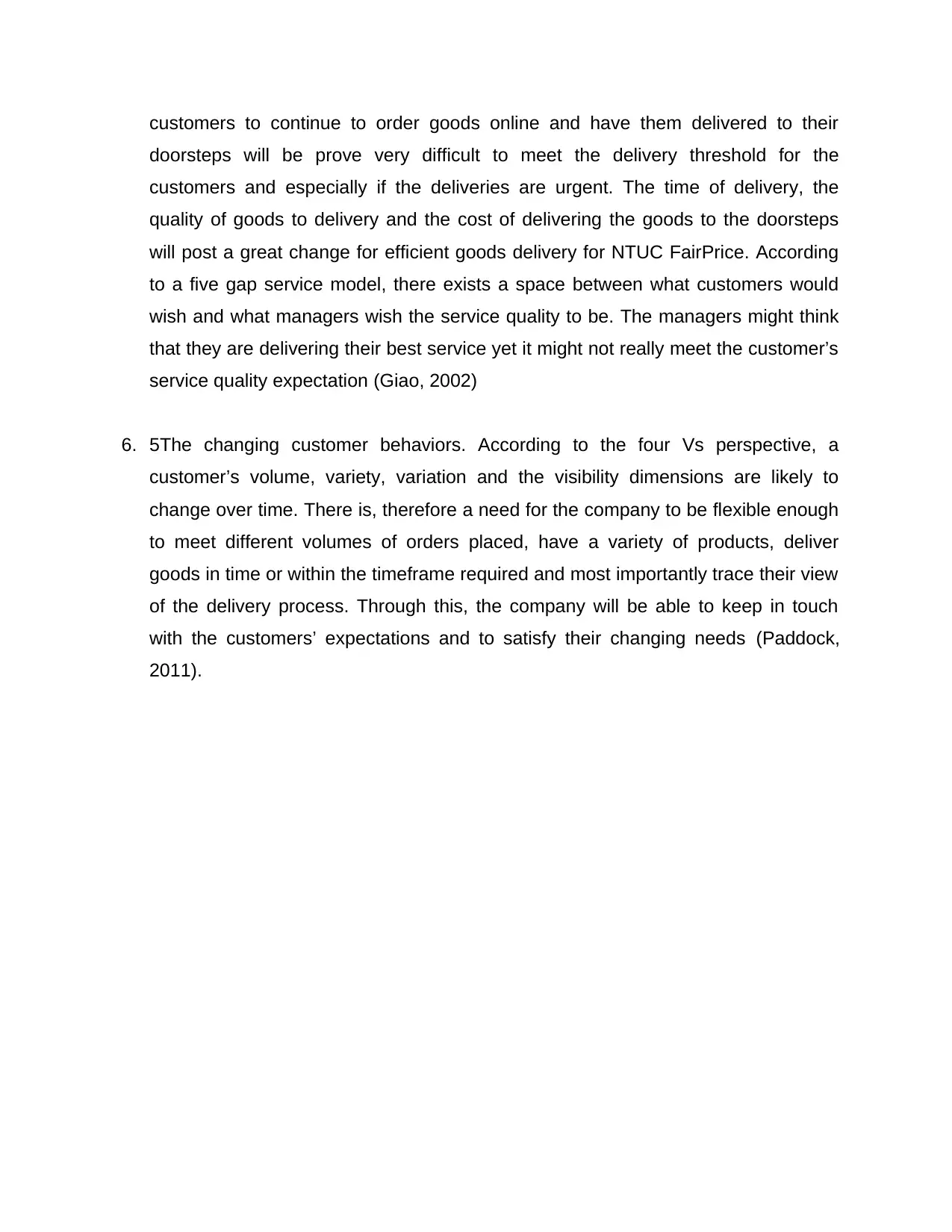
customers to continue to order goods online and have them delivered to their
doorsteps will be prove very difficult to meet the delivery threshold for the
customers and especially if the deliveries are urgent. The time of delivery, the
quality of goods to delivery and the cost of delivering the goods to the doorsteps
will post a great change for efficient goods delivery for NTUC FairPrice. According
to a five gap service model, there exists a space between what customers would
wish and what managers wish the service quality to be. The managers might think
that they are delivering their best service yet it might not really meet the customer’s
service quality expectation (Giao, 2002)
6. 5The changing customer behaviors. According to the four Vs perspective, a
customer’s volume, variety, variation and the visibility dimensions are likely to
change over time. There is, therefore a need for the company to be flexible enough
to meet different volumes of orders placed, have a variety of products, deliver
goods in time or within the timeframe required and most importantly trace their view
of the delivery process. Through this, the company will be able to keep in touch
with the customers’ expectations and to satisfy their changing needs (Paddock,
2011).
doorsteps will be prove very difficult to meet the delivery threshold for the
customers and especially if the deliveries are urgent. The time of delivery, the
quality of goods to delivery and the cost of delivering the goods to the doorsteps
will post a great change for efficient goods delivery for NTUC FairPrice. According
to a five gap service model, there exists a space between what customers would
wish and what managers wish the service quality to be. The managers might think
that they are delivering their best service yet it might not really meet the customer’s
service quality expectation (Giao, 2002)
6. 5The changing customer behaviors. According to the four Vs perspective, a
customer’s volume, variety, variation and the visibility dimensions are likely to
change over time. There is, therefore a need for the company to be flexible enough
to meet different volumes of orders placed, have a variety of products, deliver
goods in time or within the timeframe required and most importantly trace their view
of the delivery process. Through this, the company will be able to keep in touch
with the customers’ expectations and to satisfy their changing needs (Paddock,
2011).
Paraphrase This Document
Need a fresh take? Get an instant paraphrase of this document with our AI Paraphraser
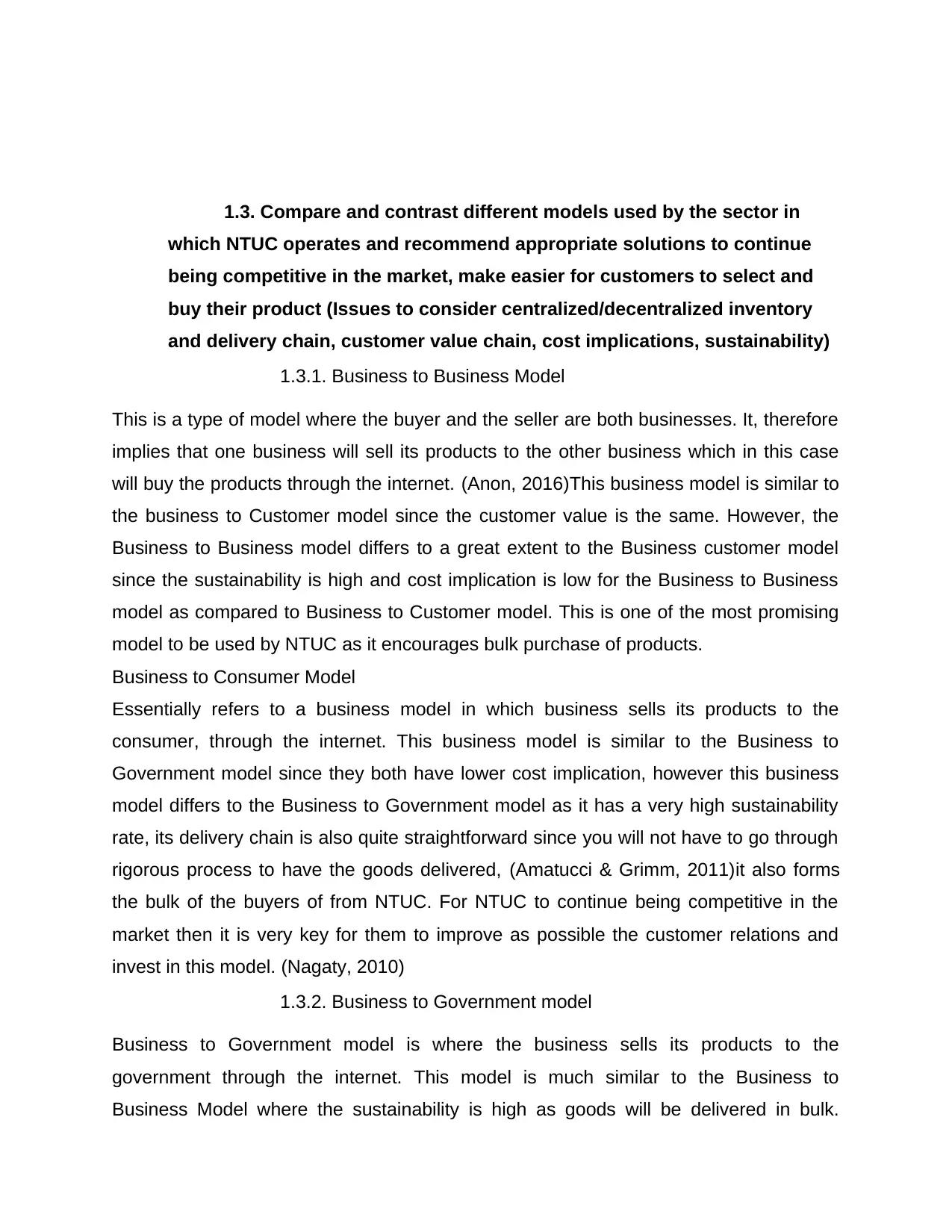
1.3. Compare and contrast different models used by the sector in
which NTUC operates and recommend appropriate solutions to continue
being competitive in the market, make easier for customers to select and
buy their product (Issues to consider centralized/decentralized inventory
and delivery chain, customer value chain, cost implications, sustainability)
1.3.1. Business to Business Model
This is a type of model where the buyer and the seller are both businesses. It, therefore
implies that one business will sell its products to the other business which in this case
will buy the products through the internet. (Anon, 2016)This business model is similar to
the business to Customer model since the customer value is the same. However, the
Business to Business model differs to a great extent to the Business customer model
since the sustainability is high and cost implication is low for the Business to Business
model as compared to Business to Customer model. This is one of the most promising
model to be used by NTUC as it encourages bulk purchase of products.
Business to Consumer Model
Essentially refers to a business model in which business sells its products to the
consumer, through the internet. This business model is similar to the Business to
Government model since they both have lower cost implication, however this business
model differs to the Business to Government model as it has a very high sustainability
rate, its delivery chain is also quite straightforward since you will not have to go through
rigorous process to have the goods delivered, (Amatucci & Grimm, 2011)it also forms
the bulk of the buyers of from NTUC. For NTUC to continue being competitive in the
market then it is very key for them to improve as possible the customer relations and
invest in this model. (Nagaty, 2010)
1.3.2. Business to Government model
Business to Government model is where the business sells its products to the
government through the internet. This model is much similar to the Business to
Business Model where the sustainability is high as goods will be delivered in bulk.
which NTUC operates and recommend appropriate solutions to continue
being competitive in the market, make easier for customers to select and
buy their product (Issues to consider centralized/decentralized inventory
and delivery chain, customer value chain, cost implications, sustainability)
1.3.1. Business to Business Model
This is a type of model where the buyer and the seller are both businesses. It, therefore
implies that one business will sell its products to the other business which in this case
will buy the products through the internet. (Anon, 2016)This business model is similar to
the business to Customer model since the customer value is the same. However, the
Business to Business model differs to a great extent to the Business customer model
since the sustainability is high and cost implication is low for the Business to Business
model as compared to Business to Customer model. This is one of the most promising
model to be used by NTUC as it encourages bulk purchase of products.
Business to Consumer Model
Essentially refers to a business model in which business sells its products to the
consumer, through the internet. This business model is similar to the Business to
Government model since they both have lower cost implication, however this business
model differs to the Business to Government model as it has a very high sustainability
rate, its delivery chain is also quite straightforward since you will not have to go through
rigorous process to have the goods delivered, (Amatucci & Grimm, 2011)it also forms
the bulk of the buyers of from NTUC. For NTUC to continue being competitive in the
market then it is very key for them to improve as possible the customer relations and
invest in this model. (Nagaty, 2010)
1.3.2. Business to Government model
Business to Government model is where the business sells its products to the
government through the internet. This model is much similar to the Business to
Business Model where the sustainability is high as goods will be delivered in bulk.
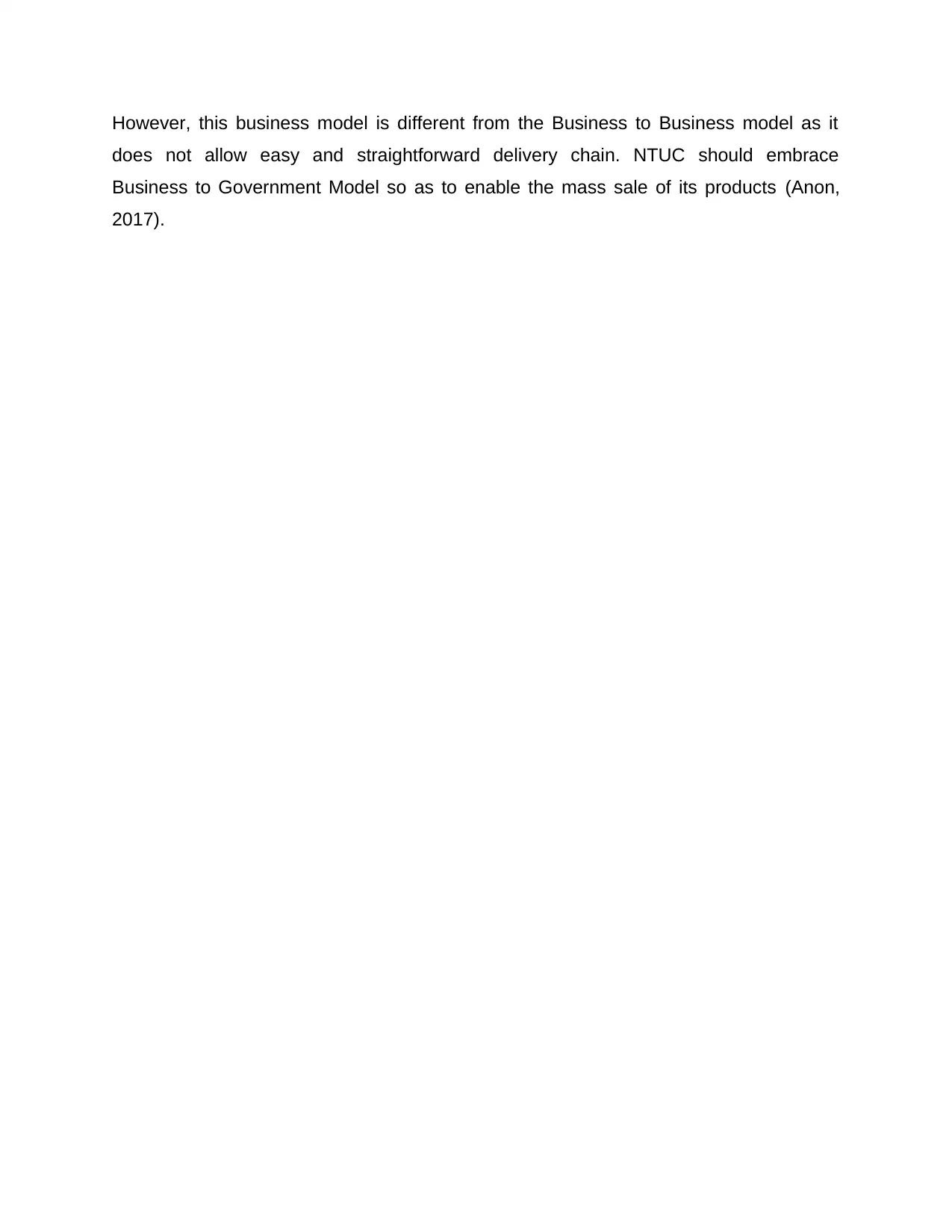
However, this business model is different from the Business to Business model as it
does not allow easy and straightforward delivery chain. NTUC should embrace
Business to Government Model so as to enable the mass sale of its products (Anon,
2017).
does not allow easy and straightforward delivery chain. NTUC should embrace
Business to Government Model so as to enable the mass sale of its products (Anon,
2017).
⊘ This is a preview!⊘
Do you want full access?
Subscribe today to unlock all pages.

Trusted by 1+ million students worldwide
1 out of 30
Related Documents
Your All-in-One AI-Powered Toolkit for Academic Success.
+13062052269
info@desklib.com
Available 24*7 on WhatsApp / Email
![[object Object]](/_next/static/media/star-bottom.7253800d.svg)
Unlock your academic potential
Copyright © 2020–2025 A2Z Services. All Rights Reserved. Developed and managed by ZUCOL.





